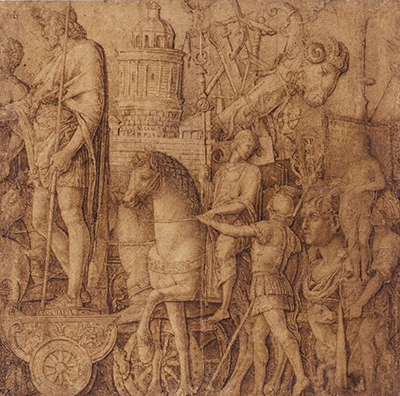The artistic discipline of drawing was given more significance within the Italian Renaissance than perhaps any other art movement since. Andrea Mantegna's skills as a draughtsman would ultimately lay behind his success within all mediums and genres in which he worked.
Mantegna would impress within painting and engraving, and would also supplement his income with series of prints. His drawings are lesser known but still significant, with many no doubt having been lost or damaged in the many centuries that have passed since his career took hold. In fact, most of the old masters have very few drawings left from their career, other than with the absolute best, the likes of Da Vinci and Michelangelo, whose careers have been researched so comprehensively that every last artwork has since been discovered and documented in detail. For the rest, including Mantegna, we are left with a selection of just a few, but there are enough for us to make some confident judgements about how he worked in this medium, as well as how technically skilled he was.
We know from a recently discovered drawing by Mantegna that the artist would sometimes work in very precise detail in preparation for later paintings. The Triumph of Alexandria, for example, is a delightful piece produced in pen and ink which provided an elaborate display of a number of figures in front of an architectural setting. The piece was sold for several million dollars in 2019 and was also featured in a recent exhibition in London which presented the work of Mantegna & Bellini together. A comparison between the drawing and the completed painting also remind us of how he would happily amend compositions significantly, even at the stage of painting. This showed a great confidence and expertise to be able to re-work paintings and allow the piece to evolve during development.
Interestingly, the drawing of The Triumph of Alexandria actually held elements which were later drawn over and this was only recently discovered from some x-ray research that was carried out around the same time that it was auctioned. This helped us to understand that the artist would not only amend his paintings as he went, but also his drawings too, and often in quite substantial ways. Some of the levels of detail inserted into his paintings was one of the hallmarks of this artist and so he would find it necessary to flesh out ideas around his compositions at earlier stages using pen and ink. Even with his ability to re-work elements substantially, a good understanding of the overall design was essential and this would be prepared prior to that stage. Some of his paintings, for example, would feature entire cityscapes across the background or large numbers of figures which were all inter related with each other within the overall perspective.
When considering the great masters, most of their drawings were studies of individual elements of an upcoming painting, rather than necessarily planning out the entire piece in one go. They would perhaps focus on a particular figure with whom they still felt unsure and work on that perhaps several times on the same piece of paper. Mantegna clearly differs from that, in going into such extraordinary detail and essentially planning the entire piece from one sleeve of paper, though it is entirely possible that there were also earlier studies which were more focused on individual elements, but have since been lost to the world. The price achieved at auction for this drawing perhaps reflects the extraordinary level of detail and also the impressive skills as a draughtsman that Mantegna had, as it is hard to imagine any drawing going for that sort of price, other than from the main three Renaissance masters of Da Vinci, Michelangelo and Raphael. Andrea was a highly significant and influential member of the next rung of artists from this important period, along with the likes of Masaccio, Giotto, Tintoretto and Paolo Uccello.
Going beyond Mantegna's own drawings, we do know that a number of artists some years after the Italian Renaissance have also studied and copied some of the artist's work. For example, the likes of Delacroix and Degas would come across his work within France and make multiple drawn copies of some of his best paintings. They also may have come into contact with other paintings that were being displayed in the UK at the time, being able to make the relatively short visit to the South East of the country, where a number of old masters' drawings are kept in a variety of collections that date back many years, some with links to the monarchy. Many of them still exist there today and can be accessed from a number of prominent art galleries which have attempted to allow more of the public to view some of these key acquisitions. There has also been a number of exhbitions in recent years which have focused on the medium of drawing, allowing some of the world's most famous artists to have some lesser known artworks from their careers receive some well deserved attention for once.
In conclusion, it is clear that Mantegna was an entirely talented and versatile artist who was well trained as a draughtsman and could then carry these abilities over to his work with engraving as well as the print process. His paintings were highly detailed in many cases and so a fair level of planning was required prior to commencing these pieces, even though he could call on the services of his assistants once his own studio had been established. Whilst impressing with his understanding of space and perspective, it was his role within Venetian art which helps to keep his name fresh in our minds. Many of his achievements would also live on in the careers of others, with a number of Renaissance artists who followed on after him taking in different elements of his style.




